How to choose heating radiators for an apartment and a private house: selection criteria and advice to customers
That in the house and apartment in the cold season it was warm and comfortable, it is important to correctly design and install the heating system. And the radiator is one of the important components. Thanks to correctly selected equipment, it is possible to ensure the efficiency of the heating system.
But among the rich assortment of batteries presented by manufacturers such as Prado, Conrad, Global Style, Tenrad, Viadrus, Konner and others, it’s hard to get it right?
You do not know how to avoid mistakes when choosing and what points should be paid attention in the first place? We will help to understand this issue - in the article we will talk in detail about the criteria for choosing radiators in a private house and apartment, which are of paramount importance.
Also consider the types of equipment and their features. We give recommendations to customers, supplementing them with visual photos and useful videos.
The content of the article:
Types of batteries and their connection
The variety of heating radiators on the market is truly amazing. And it is especially difficult to make the right choice for an unprepared user.
Therefore, in the framework of our article, we will try to examine in detail the varieties of heating devices, paying attention to their key characteristics, and give recommendations on choosing the suitable option based on living conditions, type of heating system and specific requirements of the owner.
Classifications of heating radiators
The heating devices used in the water circuit differ in design, material of manufacture, technical characteristics, design. Next, we will talk in more detail about the types of radiators and their features.
What materials are batteries made of?
As the manufacturing material for heating appliances, most often used:
- steel;
- aluminum;
- cast iron;
- a combination of two metals.
So, steel heating appliances can be sectional, panel or tubular. And, depending on the design, their technical characteristics, service life, cost will differ.
The simplest and most inexpensive are panel ones. They withstand a working pressure of up to 10 bar (the value should be found in the passport of the respective model and specific manufacturer), are vulnerable to water hammer, and leaks can occur in places of welds.
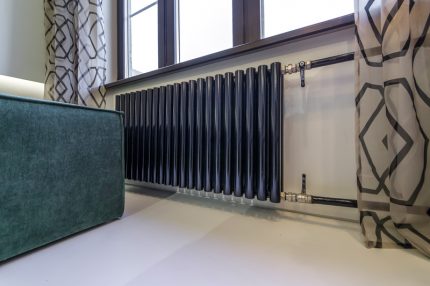
Radiators from aluminum quickly heat up and give off heat to the room, i.e. possess low inertness. Due to the large area of the heating surface with their help, you can quickly warm up the room.
Heating appliances from cast iron characterized by high inertness - warm up for a long time and cool for a long time. This property is rated positively by many users suffering from intermittent shutdowns of heating. But, on the other hand, this feature does not allow the use of cast-iron batteries in smart home systems - most models are useless to equip with temperature controllers.
Bimetal is not an alloy, but the correct combination of two metals in one product: internal elements bimetal radiator made of steel (sometimes copper), and external (body) of aluminum. Moreover, the steel can be the entire "skeleton" or its individual parts - a pipeline or vertical guides. The first option is better and more expensive.
More features of radiators from these types of materials we have given in the following selection of photos.
In addition to the materials discussed above, copper radiators can be found on the market. But the decision to equip the heating system with such devices will cost the owner of a country house a round sum due to their high cost.
Also, copper is susceptible to the quality of the coolant and requires installation skills.
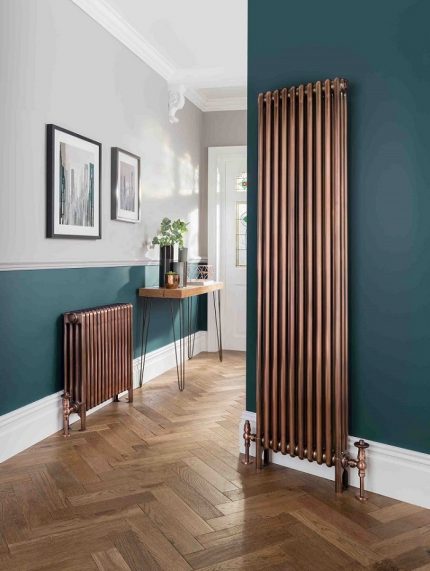
The difference in battery type design
Radiators for the heating system also differ in the type of design and this is noticeable visually.
Structurally, the batteries are:
- sectional;
- panel;
- tubular;
- lamellar.
The most common - sectional. They can be either steel or cast iron, aluminum and bimetal. Due to the ribbed surface, the heating area exceeds the physical dimensions of the product, which positively affects the efficiency of use of devices.
They consist of separate elements interconnected by means of nipple sleeves and gaskets.It is these components that are the weakest point of this type of heating appliances. But, if you follow the rules of operation and maintenance of radiators, regularly clean them and change the worn gaskets in a timely manner, then there will be no leak at the joints, and the product itself will last for many years.
Panel heating appliances - one of the most affordable offers on the market. They are lightweight, easy to install, picky to care for, quickly heat up. But also quickly and cool. Although this property allows them to be used in conjunction with temperature controllers.
Another kind of design - tubular batteries. They are most popular among designers due to the presence of a variety of shapes and sizes. They help to create a unique interior of the room, zoning the room, bring their own zest.

Tubular radiators are also quite effective, especially since the length and number of sections can be tailored to your needs.
Least Popular Batteries plate type. Such a device consists of tubes through which the coolant circulates, and plates strung on these pipes. The design provides a large heating area, which allows you to quickly and efficiently heat rooms. But the extremely unpretentious appearance has contributed to the fact that these radiators are used exclusively for heating industrial buildings and common areas.
The design features of the radiators are clearly demonstrated in the next gallery.
Type of device connection
If we talk about the connection, then for heaters for a water heating circuit it can be:
- lateral;
- lower.
Side type of connection assumes that the radiator will be connected to the heating system on the side. Why manufacturers design special holes in the product design - on the right or on the left. But some manufacturers do not limit the buyer by making four side holes, and in the manufacture of the battery brackets are not welded to it - then the device can be mounted with either a right or left connection.
Bottom connection involves connecting to the supply line and to the return flow from below. This is convenient if you need to hide pipes.
You can also conditionally highlight universal option - assumes the presence of six connecting holes in the design of the radiator - two from the bottom and two from each side. The user selects the connection method based on the characteristics of his heating system. The remaining holes are closed with plugs.
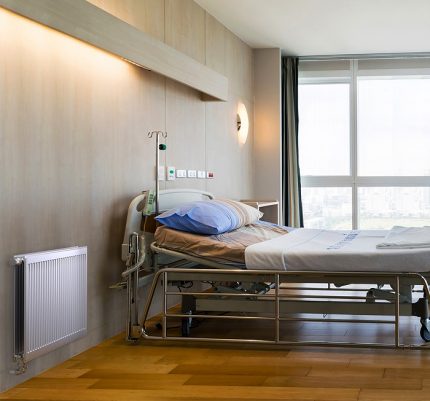
Criteria for choosing the best radiator
When choosing a suitable radiator, a number of nuances have to be taken into account, starting with the type of material and power, and ending with the design. Moreover, sometimes it is the last parameter that is crucial, especially when the designer is involved in the design of a country house.
Due to the demand for original forms and sizes of heating batteries, the modern market can offer interesting solutions. And if necessary, you can order the manufacture of a heater to order. Often, interesting products of complex shape - tubular, made of steel.
The following selection will demonstrate that the battery is an independent piece of furniture, sometimes even its highlight.
The above ideas of the original use of batteries in the interior are not limited to this selection. And if you have very simple batteries (still old Soviet ones), do not despair.
They can always be hidden behind a decorative panel or masked in another way. But in this case, you need to be prepared for heat loss at the level of 5-20% - the exact percentage of heat loss depends on masking methods, type of box, its shape and size, material of manufacture.
Next, we’ll talk about the features and characteristics of devices that are of key importance when choosing a suitable radiator.
Criterion # 1 - fabrication material
When choosing radiators for the production material, it is important to first analyze the specific operating conditions. Which will be significantly different for a private house and apartment.
The best radiators for a private home
In private houses there is autonomous heating.And this is very convenient - the owner does not depend on interruptions and sudden outages of district heating and can control the operating parameters of the system himself - system pressure, heat carrier quality and its heating temperature.
Therefore, for installation in such systems, you can use steel, aluminum, bimetallic, copper and cast-iron batteries - whatever you like. Moreover, in country houses where designers develop the interior, quite often they use tubular heating appliances of an intricate shape.
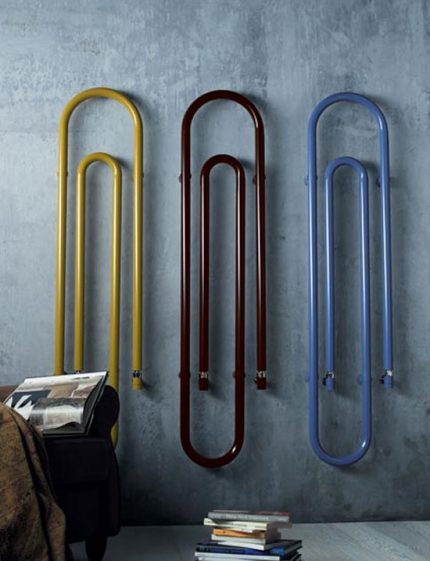
If the heating system is equipped in a small house, which will be used from time to time, and the owner has allocated a modest budget, then it is quite possible to stop on steel panel batteries - they quickly heat themselves and quickly warm up the room.
They also contain quite a bit of coolant, so a lot of time is not required to fill the system upon arrival and to drain the liquid upon departure.
The best solution for an apartment
But in apartments, in most cases, centralized heating. This means that the owners of such housing can not affect the composition and temperature of the coolant (water with impurities), the pressure in the pipeline, which is higher than in autonomous systems.
And in the case of hydroblows, it rises many times. Therefore, the purchase of panel steel batteries should be immediately abandoned, giving preference to bimetallic. Which are able to withstand a pressure of 20 bar, 50 or more.
By the way, with regard to the specific value of the working pressure, it is indicated in the instrument passport. And it would be nice to immediately ask the seller to look at the test report to make sure that the declared indicators are not embellished, but confirmed by real tests.

Separately, it is worth mentioning apartments with an autonomous heating system - the conditions are the same as those of owners of a private house. Therefore, it is not necessary to choose practical and expensive bimetallic radiators - with a tight financial situation, it is quite possible to stop on aluminum.
Criterion # 2 - type of radiator and type of connection
As for the choice of the type of design and connection, here you need to take into account specific conditions and your preferences. So, for apartments most often take sectional batteries, picking up the necessary power. But for private homes, any are suitable - panel, tubular and sectional.
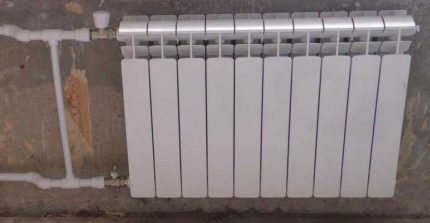
But in private homes, owners can afford to design the location of risers, pipelines and heating appliances at their discretion.
It is important when choosing radiators to immediately pay attention to the equipment - whether the accessories are for installation and connection or whether they have to be purchased separately. If you need to buy, then you should definitely pay attention to the diameter (most often 1/2 ”, but there may be another).
Criterion # 3 - heater power
Also, when choosing batteries, you must definitely focus on the thermal power of the equipment. Indeed, for the installation of an effective heating system calculate power radiators.
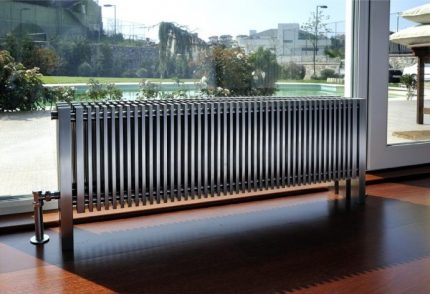
Before buying, be sure to check which power indicator is indicated in the instrument passport and compare whether it corresponds to the figure noted in the test report.
Many manufacturers do not conduct any tests at all, and enter in the passport any suitable value attractive to potential buyers. Naturally, the products of such firms are best avoided.
Criterion # 4 - heating / cooling rate
The rate of temperature change by radiators is important if the plans include a climate control system. For such purposes, devices with low inertia are suitable - they quickly heat up and cool down.
That allows you to set the desired temperature in the room and control its values by equipping radiators temperature controllers.
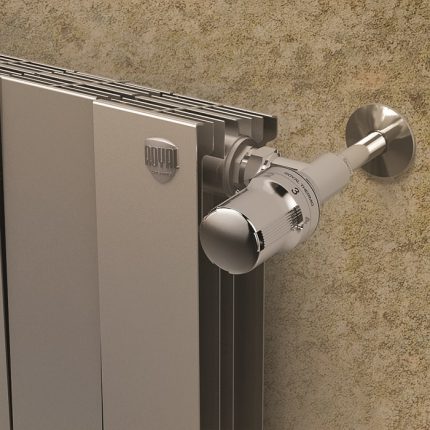
Criterion # 5 - Manufacturer Reputation
When choosing a radiator, it is better to give preference to trusted brands with a good reputation, among which:
- Steel - Lidea, Conrad, Prado, Charlston, Kermi, Arbonia, Israp Tesi, Buderus PURMO, Delonghi, Korado.
- Aluminum - Global, Rifar, Ferroli, Purmo, Radena, Faral Trio.
- Cast iron - Adarad, Viadrus, Demrad, KIRAN, Konner, Cheboksary Plant and Minsk Plant.
- Bimetallic - Global Style, Sira, Rifar, Tenrad, Halsen, Radena, Rommer.
As you can see, many manufacturers produce more than one type of radiator, which differ in the material of manufacture and other characteristics.
But sometimes it is difficult to distinguish an aluminum radiator from a bimetallic one, the cost of which is much higher. Which can take advantage of an unscrupulous seller. Therefore, before buying, you can conduct a test, for example, with a magnet - a magnet will always be attracted to bimetal.
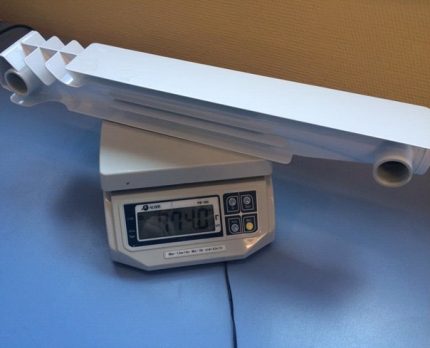
All respectable manufacturers of heating equipment on the market produce marked products that meet the requirements of GOST 31311-2005.
Therefore, if the model you like does not have accompanying documents, there is no marking on the radiator case, then this is a fake or a product of an unknown manufacturer. Buying such a device is a dubious undertaking.
Conclusions and useful video on the topic
Detailed recommendations for choosing heating appliances:
The test of steel radiators is clearly demonstrated in this video:
Properly selected heating radiators will ensure a comfortable temperature in the cold season. It is important not only to correctly determine the power of heating devices, but also to take into account the type of material - not every radiator can withstand the impact coolantcirculating in the pipeline of a centralized heating system.
Particularly damaging are the impurities contained in the liquid on the walls of aluminum radiators. Therefore, it is better for apartment owners to opt for cast-iron and bimetallic batteries.
And in a private house you can install radiators from any material - the main thing during operation is to adhere to the recommendations prescribed by the manufacturer in the instructions.
Still have questions about choosing the right heater for your heating system? Or want to share your personal experience in selecting and installing radiators? Tell us which batteries of which material you preferred and are you satisfied with your choice, ask questions to our experts and participate in the discussion - the comment form is located below.

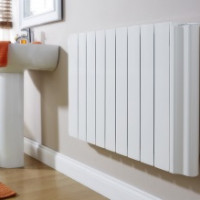 Vacuum heating radiators: overview of types, selection rules + installation technology
Vacuum heating radiators: overview of types, selection rules + installation technology 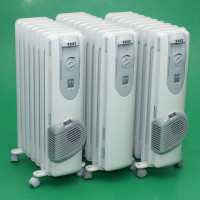 How to choose an oil heater: tips for customers and an overview of the best options
How to choose an oil heater: tips for customers and an overview of the best options 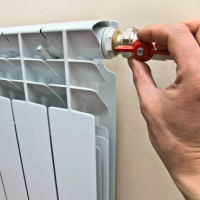 Aluminum heating radiators: overview of technical characteristics + installation principles
Aluminum heating radiators: overview of technical characteristics + installation principles  How to choose an infrared carbon heater: an overview of the types and tips for customers
How to choose an infrared carbon heater: an overview of the types and tips for customers 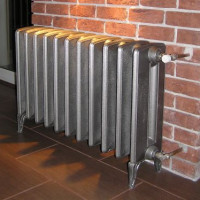 Cast-iron radiators: characteristics of batteries, their advantages and disadvantages
Cast-iron radiators: characteristics of batteries, their advantages and disadvantages  Vertical heating radiators: types + advantages and disadvantages + brand overview
Vertical heating radiators: types + advantages and disadvantages + brand overview  How much does it cost to connect gas to a private house: the price of organizing gas supply
How much does it cost to connect gas to a private house: the price of organizing gas supply  The best washing machines with dryer: model rating and customer tips
The best washing machines with dryer: model rating and customer tips  What is the color temperature of light and the nuances of choosing the temperature of the lamps to suit your needs
What is the color temperature of light and the nuances of choosing the temperature of the lamps to suit your needs  Replacement of a geyser in an apartment: replacement paperwork + basic norms and requirements
Replacement of a geyser in an apartment: replacement paperwork + basic norms and requirements